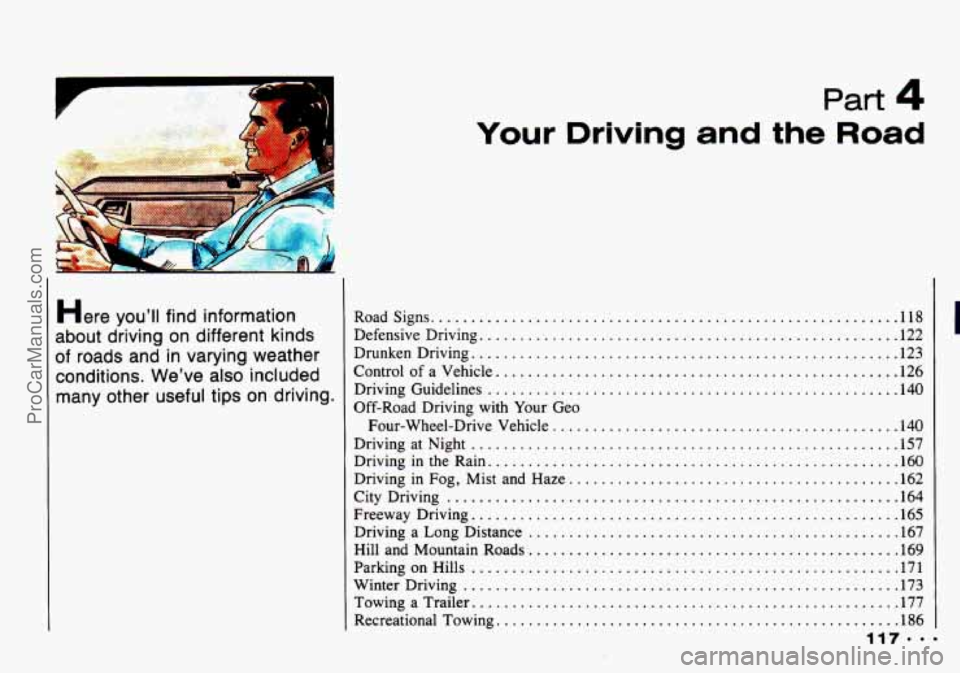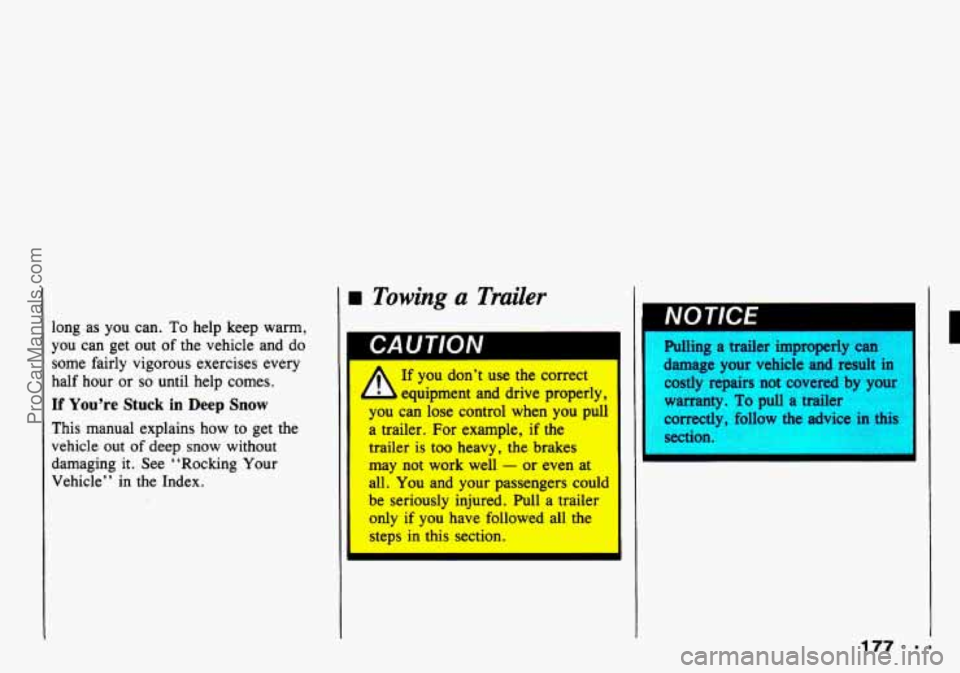1993 CHEVROLET TRACKER towing
[x] Cancel search: towingPage 53 of 339

r
Automatic Transmission
There are several different positions for
your shift lever.
P (Park)
This locks your rear wheels. It’s the
best position to use when you start your
engine because your vehicle can’t move
easily.
GAU I IUN I
It can be dangerous to get out
of your vehicle if the shift
lever is not
fully in P (Park) with
the parking brake firmly set. Your
vehicle could roll.
Don’t leave your vehicle when the
engine is running unless you have
to. If you have ieft the engine
running, the vehicle can move
suddenly. You or others could be
injured. To be sure your vehicle
won’t move, when you’re on fairly
level ground, always set your
parking brake and move the shift
lever
to P (Park).
If you have four-wheel drive, your
vehicle will be free to roll
- even
if your shift lever is in P (Park) - I
if your transfer case is in
N (Neutral). So, be sure the
transfer case is
in a drive gear -
not in N (Neutral).
See “Shifting into
P (Park)’’ in
the Index.
If you are parking on a
hill, or,
if you’re pulling a trailer,
also see “Parking
on Hills” or
“Towing a Trailer’’ in the Index.
I P (Park) range before starti& the
engine. Your Geo has a
brake-transmission shift interlock.
You
have to fully apply your regular brakes
before you can shift from P (Park)
when the ignition is in
the ON position.
If you cannot shift out of P (Park), ease
pressure on the shift lever
- push the
shift lever all the way into
P (Park) and
also release the shift lever button on
floor shift console models
- as you
maintain brake application. Then move
the shift lever into the gear you wish.
(Press the shift lever button before
moving the shift lever on floor shift
models.) See “Shifting Out of
P (Park)’’ in the Index.
51 ..=
ProCarManuals.com
Page 59 of 339

Four-wheel Drive
CAUTION I
It can be dangerous to get out
4 b of your vehicle if the shift
rcyer is not fdly in P (Park)
(automatic transmission) or
R (Reverse) (manual transmission)
with the parking brake firmly set.
If you have four-wheel drive, also
be sure the transfer case is in a
drive gear. Your vehicle can roll.
If you have left the engine
running,
the vehicle can move
suddenly.
You or others could be
injured. To be sure your vehicle
won’t move, follow the step
below. If you are parking on a
hill’, or if you’re pulling a trailer,
see “Parking on Hills” cw
“Towing a Trailer” in the Index.
[f your vehicle has four-wheel drive,
you can send your engine’s driving
power to all four wheels for extra
traction.
To shift out of two-wheel drive
and into four-wheel drive, lock the
free-wheeling hubs and move
the
transfer case shift lever to 4H or 4L
(see the following). You should use 2H
for most normal driving.
Rear wheel anti-lock brakes
do not work
when you shift into four-wheel drive.
Your regular brakes will still work.
When
you shift back into two-wheel
drive, your rear wheel anti-lock brakes
will take over again. Driving
in 4H or 4L positions for
a long time on dry or wet
pavement could shorten
thP 1 nf
your vehicle’s drivetrain.
ProCarManuals.com
Page 63 of 339

To release the parking brake: Hold the
brake pedal down. Pull the parking
brake lever up
until you can push in the
release button. Hold the release button
in as you move the brake lever all the
way down.
I NOTICE
Driving with the parking brake on
can cause your rear brakes to
overheat.
You may have to replac=
them, and
you could also dvwe
other parts
of your vehicle.
If you are on a hill: See “Parking on
Hills” in
the Index. That section shows
how to turn your front wheels.
If you are towing a trailer and are
parking on any hill:
See “Towing a
Trailer”
in the Index. That section
shows what to
do first to keep the trailer
from moving.
Shifiing into P (Park)
(AUTOMATIC TRANSMlSS/ON)
It can be dangerous to get out
of your vehicle if
the shift
lever is not fully in
P (Park) with
the parking brake firmly set. Your
vehicle can roll,
If you have left the engine
running, the vehicle can move
suddenly. You or others could be
injured. To be sure your vehicle
won’t move, when you’re on fairly
level ground, use the steps that
follow.
If you have four-wheel drive and
your transfer case
is in
N (Neutral), your vehicle will be
free
to roll even if your shift lever
is in
P (Park). So, be sure the
transfer case
is in a drive gear -
not in N (Neutral).
If
you are parking on a hill, or if
you’re pulling a trailer, also see
‘‘Parking on Hills”
or ‘‘Towing a
Trailer” in the Index.
ProCarManuals.com
Page 66 of 339

Features & Controls
If you are parking on a hill, or if you’re
vehicle
is equipped to tow a trailer, see
“Parking on Hills” or “Towing a
Trailer’
’ in the Index.
Engine Exhaust #
t
Parking over Things That Burn
uwu I IVIY
Things that burn could touch
L L hot exhaust parts under your
vehicle and ignite. Don’t park over
papers, leaves, dry grass or other
things that can burn.
A
Engine exhaust can kill. It
contains the gas carbon
monoxide
(CO), which you can’t see
or smell. It can cause
unconsciousness and death.
You might have exhaust coming
in
if:
Your exhaust system sounds
strange or different.
Your vehicle gets
rusty
underneath.
Your vehicle was damaged in a
collision.
Your vehicle was damaged when
driving over high points
on the
road or over road debris.
Repairs weren’t done correctly.
Your vehicle or exhaust system
had been modified improperly.
If you ever suspect exhaust is
coming into your
vehicle:
Drive it only with all the windows
down
to blow out any CO; and
Have it fixed immediately.
ProCarManuals.com
Page 67 of 339

Running Your Engine While
You’re Parked
(AUTOMATIC TRANSMISSION)
It’s better not to park with the engine
running. But if
you ever have to, here
are some things to
know.
CAUTION
A
Idling the engine with the air system control off could allow dangerous
exhaust into your vehicle (see
the earlier Caution under “Engine
Exhaust’
’).
Also, idling in a closed-in place can let deadly carbon monoxide (CO) into
your vehicle even if
the fan switch is at the highest setting. One place this
can happen is a garage. Exhaust - with CO - can come in easily. NEVER
park in a garage with
the engine running.
Another closed-in place can be a blizzard. (See “Blizzard”
in the Index.)
It can be dangerous to get out of your vehicle if the shift lever is not
fully in
P (Park) with the parking brake firmly set. Your vehicle can roll. Don’t
leave your vehicle when
the engine is running unless you have to. If you’ve
left the engine running, the vehicle can move suddenly. You or others could
be injured.
To be sure your vehicle won’t move, even when you’re on fairly
level ground, always set your parking brake and move the shift lever
to P
(Park).
If you have four-wheel drive and your transfer case
is in N (Neutral), your
vehicle will be free to roll, even
if your shift lever is in P (Park). So, be sure
the transfer case
is in a drive gear - not in N (Neutral). Follow the proper
steps to be sure your vehicle won’t move. See “Shifting into
P (Park)” in
the Index.
If you are parking on a hill, or if you’re pulling a trailer, also see “Parking
on Hills” or “Towing a Trailer” in the Index.
c
ProCarManuals.com
Page 86 of 339

Features & Controls
. . .a4
Brake System Warning Light
Your Geo’s hydraulic brake system is
divided into two parts.
If one part isn’t
working, the other part can still work
and stop you.
For good braking, though,
you need both parts working well.
Your vehicle also has rear wheel
anti-lock brakes. If the warning light
goes on, there could be a brake problem
with either your regular or rear wheel
anti-lock brakes,
or both. Have your
brake system inspected right away.
This light should come
on as you start
the vehicle. If it doesn’t come on then,
have
it fixed so it will be ready to warn
you if there’s a problem. This light will
also come on when you
set your parking brake, and it
will stay
on if your parking brake doesn’t release
fully. If it stays on after your parking
brake is fully released, it means you
may have a brake problem.
If the light comes on while driving, pull
off the road and stop carefully. You
may notice that the pedal is harder to
push.
Or, the pedal may go closer to the
floor. It may take longer to stop. If the
light is still on, have the vehicle towed
for service. (See “Towing
Your
Vehicle” in the Index.)
$ Your brake system may not
be working properly if the
brake warning light
is on. Driving
with the brake warning light on
can lead to an accident.
If the light
is still on after you’ve pulled off
the road and stopped carefully,
have the vehicle towed for service.
I
ProCarManuals.com
Page 119 of 339

Here YOU’II find information
about driving on different kinds
of roads and in varying weather
conditions
. We’ve also included
many other useful tips on driving
.
Part 4
Your Driving and the Road
Roadsigns .......................................................... 118
DefensiveDriving
.................................................... 122
DrunkenDriving
..................................................... 123
Control of a Vehicle
.................................................. 126
Driving Guidelines
................................................... 140
Off-Road Driving with Your
Geo
Four-Wheel-Drive Vehicle ....................................... 140
Drivingat Night
..................................................... 157
Driving in the Rain
................................................... 160
Driving in Fog. Mist and Haze
......................................... 162
City Driving
........................................................ 164
Freeway Driving
..................................................... 165
Driving a Long Distance
.............................................. 167
Hilland MountainRoads
.............................................. 169
ParkingonHills
..................................................... 171
Winter Driving
...................................................... 173
TowingaTrailer
..................................................... 177
Recreational Towing
.................. ......................... 186
117 . =
ProCarManuals.com
Page 179 of 339

long as you can. To help keep warm,
you can get out of the vehicle and do
some fairly vigorous exercises every
half hour
or so until help comes.
If You’re Stuck in Deep Snow
This manual explains how to get the
vehicle out of deep snow without
damaging it. See “Rocking
Your
Vehicle” in the Index.
rn Towing a Trailer
Pulling a trailer improperly can
damage your vehicle and result in
costly repairs not covered by you
warranty.
To pull a trailer
correctly, follow the advice in this
section.
I
ProCarManuals.com